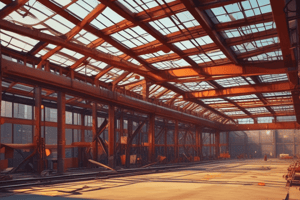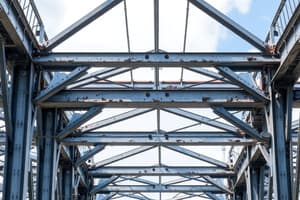Podcast
Questions and Answers
What is the primary component of steel?
What is the primary component of steel?
- Iron (correct)
- Copper
- Aluminum
- Silicon
Which type of steel offers the greatest hardness but the least ductility?
Which type of steel offers the greatest hardness but the least ductility?
- Medium Carbon Steel
- Cast Iron
- High Carbon Steel (correct)
- Low Carbon Steel
What percentage of carbon does low carbon steel contain?
What percentage of carbon does low carbon steel contain?
- 2–4%
- 1–2%
- 0.35–0.50%
- 0.05–0.32% (correct)
What is one of the most common applications for steel?
What is one of the most common applications for steel?
Which property of steel makes it suitable for structural applications?
Which property of steel makes it suitable for structural applications?
What is a common application of cast iron in industry?
What is a common application of cast iron in industry?
What is a significant advantage of using steel as a material in construction?
What is a significant advantage of using steel as a material in construction?
Which of the following elements is added to steel to enhance its properties?
Which of the following elements is added to steel to enhance its properties?
What is a characteristic disadvantage of steel?
What is a characteristic disadvantage of steel?
What is the yield strength range of common steel grades?
What is the yield strength range of common steel grades?
What happens to steel when subjected to repeated stress?
What happens to steel when subjected to repeated stress?
Which of the following is an advantage of using ductile materials?
Which of the following is an advantage of using ductile materials?
What is a recommended practice to avoid brittle fracture in steel?
What is a recommended practice to avoid brittle fracture in steel?
Which type of steel is known for its resistance to rust and staining?
Which type of steel is known for its resistance to rust and staining?
What is one of the primary elements in carbon steel that influences its properties?
What is one of the primary elements in carbon steel that influences its properties?
What can be used as a fire protection measure for steel?
What can be used as a fire protection measure for steel?
Flashcards
What is steel?
What is steel?
Steel is an alloy primarily composed of iron with a small percentage of carbon (usually 1-2%).
What is strength?
What is strength?
The ability of a metal to withstand forces without breaking. It's measured as the stress required to cause failure.
What is ductility?
What is ductility?
The ability of a material to deform under stress without breaking. Steel is incredibly durable.
What is resistance to wear?
What is resistance to wear?
Signup and view all the flashcards
Types of steel
Types of steel
Signup and view all the flashcards
Low Carbon Steel (Mild Steel)
Low Carbon Steel (Mild Steel)
Signup and view all the flashcards
Medium Carbon Steel
Medium Carbon Steel
Signup and view all the flashcards
High Carbon Steel (Tool Steel)
High Carbon Steel (Tool Steel)
Signup and view all the flashcards
Ductility
Ductility
Signup and view all the flashcards
Stress-Strain Relationship of Steel
Stress-Strain Relationship of Steel
Signup and view all the flashcards
Fatigue in Steel
Fatigue in Steel
Signup and view all the flashcards
Corrosion of Steel
Corrosion of Steel
Signup and view all the flashcards
Protection Methods for Steel
Protection Methods for Steel
Signup and view all the flashcards
Carbon Steel
Carbon Steel
Signup and view all the flashcards
Alloy Steel
Alloy Steel
Signup and view all the flashcards
Tool Steel
Tool Steel
Signup and view all the flashcards
Study Notes
Introduction to Steel
- Steel is a critical material in civil engineering.
- Steel is an alloy of iron and carbon, often with other elements to enhance properties.
- Steel is approximately 95% iron.
- Steel typically contains 1-2% carbon.
- Other trace elements, like manganese and nickel, are also present.
Learning Objectives
- Understand structural steel types.
- Discuss stress-strain relationships.
- Highlight the advantages and disadvantages of steel.
- Explore fatigue failure.
- Discuss brittle fracture and fire performance.
What is Steel?
- Steel's composition includes iron and carbon.
- Other elements are added to optimize steel properties.
Properties of Steel
- High strength
- Ductility
- Malleability
- Resistance to wear makes it suitable for structural applications.
Types of Steel
- Low Carbon (Mild) Steel
- Medium Carbon Steel
- High Carbon (Tool) Steel
- Cast Iron
Low Carbon Steel
- Contains 0.05-0.32% carbon.
- Used for nails, screws and structural components.
- Offers high ductility and weldability.
- Lower corrosion resistance, requiring coatings.
Medium Carbon Steel
- Contains 0.35-0.50% carbon.
- Offers increased strength and hardness.
- Lower ductility and malleability compared to low carbon steel.
- Suitable for structural steel and rails.
High Carbon Steel
- Contains 0.55-1.50% carbon.
- Very hard, but less ductile.
- Used for hand tools, chisels, and saw blades.
Cast Iron
- Contains 2-4% carbon.
- Hard, brittle and strong under compression.
- Used in engine blocks and machine parts.
Structural Steel Applications
- Multi-story building skeletons
- Industrial buildings
- Transmission towers
- Railway bridges
- Reinforced concrete rebar
Advantages of Steel
- High strength-to-weight ratio.
- Lightweight, aiding transportation.
- Long lifespan with minimal maintenance.
- Ductility provides failure warnings.
- Easy to alter or extend.
- Fast construction.
- High scrap value.
- Reusable after demolition.
Disadvantages of Steel
- Susceptibility to corrosion (requires coating).
- Needs fireproofing treatment.
- Fatigue reduces strength under repeated stress.
Stress-Strain Relationship
- Steel deforms elastically before yielding.
- Plastic deformation becomes permanent beyond the yield point.
Grades of Steel
- Common grades include S275, S355, and S460.
- Yield strength ranges from 275-460 N/mm².
- Grade indicates the strength of the steel.
Fatigue in Steel
- Repeated stress leads to gradual cracking and failure.
- Avoid abrupt changes in section to prevent fatigue failure.
- Bolted joints are preferable to welded joints to minimize fatigue.
Brittle Fracture
- Occurs at low temperatures or stress concentrations.
- Avoid abrupt changes in design.
- Choose steel grades resistant to brittle failure.
Fire Performance
- Steel loses strength at high temperatures.
- Yield stress drops by ~30% at 550°C.
- Use fireproofing measures like coatings or concrete encasing.
Corrosion of Steel
- Corrosion occurs in the presence of moisture or oxygen.
- Protection methods include galvanization, paint coatings, and specialized alloys.
Carbon Steel
- Carbon is the primary alloying element.
- Higher carbon content increases strength, but reduces ductility.
Alloy Steel
- Contains additional elements like chromium, nickel, and molybdenum.
- Improves toughness, hardness, and wear resistance.
Tool Steel
- Known for hardness and ability to hold an edge.
- Used in cutting tools and dies.
Stainless Steel
- Contains more than 10.5% chromium.
- Resistant to rust and staining.
- Used in kitchens, architecture, and medical tools.
Structural Steel Design
- Based on yield strength, ductility/weldability, and impact resistance.
Hot Rolled Sections
- Examples include universal beams (UB), channels, and tubes.
- Used in large frameworks.
Cold Rolled Sections
- Examples include corrugated steel roofs and wall panels.
- Ligher and easier to handle than hot rolled sections.
Fabricated Sections
- Built-up sections like I-beams and box girders are used for high-strength applications.
Future of Steel
- Emerging trends include advanced alloys, sustainable practices (recycling), and smart materials for adaptive construction.
Conclusion
- Steel is crucial in modern construction.
- It balances versatility, strength, and sustainability.
Studying That Suits You
Use AI to generate personalized quizzes and flashcards to suit your learning preferences.




